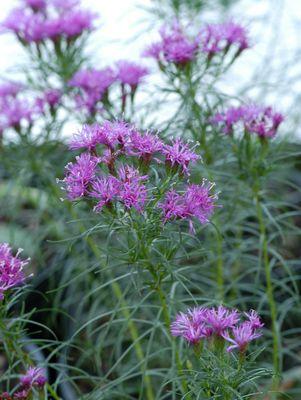Common Name: Prairie Ironweed
Bloom Time: Late summer (August–September)
USDA Zones: 3–9
Mature Size: 4–6 ft tall × 2–3 ft wide
Introduction
As summer wanes and many garden perennials begin to fade, Prairie Ironweed emerges in glorious purples, casting tall, wispy plumes of nectar-rich flowerheads atop sturdy stems. A true native of Midwestern prairies, Vernonia fasciculata brings vertical interest, wildlife value, and late-season drama to South East Wisconsin landscapes. In this spotlight, we’ll delve into its natural history, cultural needs, care guidelines, and inspiring landscape uses—everything you need to showcase Ironweed at Heritage Hill Nursery from August 22 through August 31.
Origins and Description
Native to prairies, meadows, and streambanks of the central and eastern United States, Prairie Ironweed has long been prized for its hardiness and bold form. Unlike its cousin, Vernonia noveboracensis, which often nods its heads, V. fasciculata maintains an upright, saxophone-like posture. Narrow, lance-shaped leaves cluster along stiff, reddish stems. In late summer, terminal clusters of tiny, tubular florets—each only ⅓″ across—collectively form airy corymbs measuring 3–5″ across. The intense magenta-purple hue unfolds in waves, attracting bees, butterflies (notably Monarchs and Swallowtails), and even hummingbirds.
Ideal Growing Conditions
-
Light: Full sun (at least 6–8 hours daily) ensures robust flowering and strong stem development.
-
Soil: Adaptable to a variety of soils—from sandy loams to heavier clays—as long as it’s well-drained. Ironweed tolerates occasional wet feet, making it suitable for rain gardens and bioswales.
-
pH: Prefers neutral to slightly acidic soils (pH 6.0–7.0).
-
Moisture: Consistent moisture throughout the growing season promotes larger blooms; however, established plants withstand short droughts.
-
Hardiness: Withstands Wisconsin’s winter lows (down to –40°F in Zone 3) once established. A late-fall mulch helps protect crowns from freeze–thaw cycles.
Planting and Establishment
-
Timing: Plant in spring after danger of frost has passed (mid-April–May) or in early fall (late September–early October).
-
Site Preparation: Clear the area of weeds and grass competition. Amend heavy soils with compost (up to 25% by volume) to improve structure.
-
Planting: Dig a hole twice as wide as the root ball and of equal depth. Position the crown level with surrounding soil. Backfill gently, firming soil to eliminate air pockets.
-
Mulching & Watering: Apply a 2″–3″ layer of organic mulch, keeping it an inch from the stem base. Water deeply at planting, then about 1″ per week until established (two growing seasons).
Care and Maintenance
-
Watering: Use drip irrigation or soaker hoses to maintain even soil moisture in summer. Reduce watering once plants mature.
-
Fertilization: Ironweed rarely needs fertilization if planted in average soils. If growth is slow, a light spring application of a balanced, slow-release fertilizer encourages vigor.
-
Staking: In windy sites or if crowded, consider discreetly staking stems to prevent lodging.
-
Pest & Disease: Generally pest-free. Good spacing (2–3′ apart) and air circulation reduce the risk of powdery mildew.
Pruning and Propagation
-
Pruning: Cut back spent flower stalks after bloom to tidy the garden and potentially encourage a light rebloom. In late fall or early spring, cut stems to 6″ above ground to encourage fresh growth.
-
Division: Every 3–4 years, divide large clumps in early spring. This refreshes vigor and provides additional plants for the landscape.
-
Seed: Ironweed self-seeds readily—collect seeds in autumn for sowing in flats or direct sow in prepared beds. Stratification for 60–90 days improves germination.
Landscape Uses and Companions
-
Prairie & Meadow Gardens: The quintessential tallgrass prairie component, Ironweed adds late-season color and supports pollinators.
-
Rain Gardens & Bioswales: Its tolerance for moisture fluctuations makes it perfect for managing stormwater while providing habitat value.
-
Back of Border: Use as a tall, textural backdrop behind shorter late-summer bloomers.
-
Cut Flowers & Dried Arrangements: Sturdy stems and vibrant flowerheads make excellent fresh or dried cut blooms.
Companion Plants:
-
Grasses: Little Bluestem (Schizachyrium scoparium), Switchgrass (Panicum virgatum)
-
Perennials: Obedient Plant (Physostegia virginiana), New York Ironweed (Vernonia noveboracensis), Joe-Pye Weed (Eutrochium purpureum), Purple Prairie Clover (Dalea purpurea)
Ecological Benefits
-
Pollinators: Nectar source for bees, butterflies, and hummingbirds.
-
Wildlife: Provides late-season forage; seed heads attract songbirds in autumn.
-
Soil Health: Deep roots stabilize soil and improve structure over time.
Conclusion
Prairie Ironweed stands tall—both literally and figuratively—as a multi-functional, show-stopping perennial for South East Wisconsin gardens. Whether you’re planting a native meadow, enhancing a rain garden, or seeking a late-summer focal point, Vernonia fasciculata delivers color, height, and ecological value.

